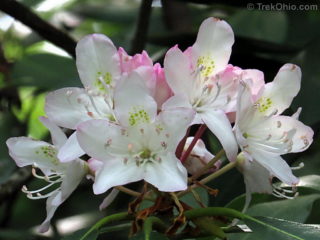 Below are the blossoms of Rhododendron Maximum (also known as Great Rhododendron, Rosebay Rhododendron, American Rhododendron, Big Rhododendron, Bigleaf Laurel, Deertongue Laurel, Great Laurel, White Laurel, Rose Tree, or Rose bay). It is a shrub that is native to a few counties in southeast Ohio. In particular, it is found at two adjacent nature preserves: Rhododendron Cove and Wahkeena. We visited both to see it in bloom.
At Rhododendron Cove only a few of the shrubs were beginning Read more ➜
Below are the blossoms of Rhododendron Maximum (also known as Great Rhododendron, Rosebay Rhododendron, American Rhododendron, Big Rhododendron, Bigleaf Laurel, Deertongue Laurel, Great Laurel, White Laurel, Rose Tree, or Rose bay). It is a shrub that is native to a few counties in southeast Ohio. In particular, it is found at two adjacent nature preserves: Rhododendron Cove and Wahkeena. We visited both to see it in bloom.
At Rhododendron Cove only a few of the shrubs were beginning Read more ➜ Rhododendron Maximum in Bloom
 Below are the blossoms of Rhododendron Maximum (also known as Great Rhododendron, Rosebay Rhododendron, American Rhododendron, Big Rhododendron, Bigleaf Laurel, Deertongue Laurel, Great Laurel, White Laurel, Rose Tree, or Rose bay). It is a shrub that is native to a few counties in southeast Ohio. In particular, it is found at two adjacent nature preserves: Rhododendron Cove and Wahkeena. We visited both to see it in bloom.
At Rhododendron Cove only a few of the shrubs were beginning Read more ➜
Below are the blossoms of Rhododendron Maximum (also known as Great Rhododendron, Rosebay Rhododendron, American Rhododendron, Big Rhododendron, Bigleaf Laurel, Deertongue Laurel, Great Laurel, White Laurel, Rose Tree, or Rose bay). It is a shrub that is native to a few counties in southeast Ohio. In particular, it is found at two adjacent nature preserves: Rhododendron Cove and Wahkeena. We visited both to see it in bloom.
At Rhododendron Cove only a few of the shrubs were beginning Read more ➜ 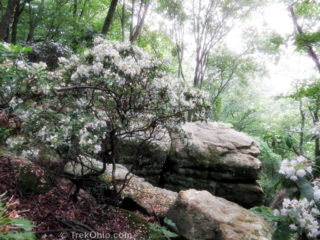 Mountain laurel is also known as calico bush or spoonwood. As a mature shrub this evergreen plant can grow to be anywhere between 9.8 feet to 29.5 feet in height (3 m to 9 m). It is native to the eastern United States, and it prefers to grow on rocky cliffs in acidic soil. Although it is a member of the blueberry family, no part of the plant is safe to eat. Even the pollen is poisonous which means that honey made from its pollen is also toxic. Besides being potentially lethal to humans, it is also
Mountain laurel is also known as calico bush or spoonwood. As a mature shrub this evergreen plant can grow to be anywhere between 9.8 feet to 29.5 feet in height (3 m to 9 m). It is native to the eastern United States, and it prefers to grow on rocky cliffs in acidic soil. Although it is a member of the blueberry family, no part of the plant is safe to eat. Even the pollen is poisonous which means that honey made from its pollen is also toxic. Besides being potentially lethal to humans, it is also 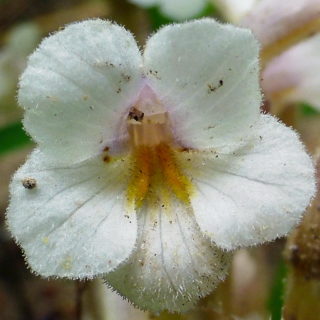 One-flowered broomrape (Orobanche uniflora) is also known as oneflowered broomrape, naked broomrape, cancer root, one-flowered cancer root, pipes, ghost pipes, squawdrops, and squirrel's grandfather. It is the fourth plant that we've dealt with here that has no chlorophyll. Without chlorophyll the plant is unable to nourish itself through photosynthesis, so it lives its life as a parasite, siphoning off its nourishment from other plants. Unlike the previous parasitic plants that we've discussed,
One-flowered broomrape (Orobanche uniflora) is also known as oneflowered broomrape, naked broomrape, cancer root, one-flowered cancer root, pipes, ghost pipes, squawdrops, and squirrel's grandfather. It is the fourth plant that we've dealt with here that has no chlorophyll. Without chlorophyll the plant is unable to nourish itself through photosynthesis, so it lives its life as a parasite, siphoning off its nourishment from other plants. Unlike the previous parasitic plants that we've discussed, 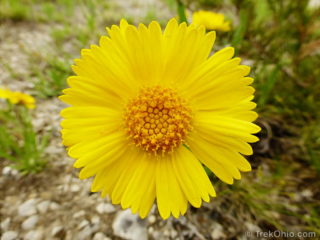 The Lakeside daisy is Ohio's rarest, native plant species. This plant only grows in four areas. Its largest population is in Ohio's Marblehead peninsula, part of Ottawa County. This is where the Lakeside Daisy State Nature Preserve is located. Lakeside daisies are also found in Michigan's upper peninsula, and in Ontario, Canada they can be found in the Bruce Peninsula and Manitoulin Island.
Lakeside daisies are the only representatives of their genus that live east of the Mississippi.
The Lakeside daisy is Ohio's rarest, native plant species. This plant only grows in four areas. Its largest population is in Ohio's Marblehead peninsula, part of Ottawa County. This is where the Lakeside Daisy State Nature Preserve is located. Lakeside daisies are also found in Michigan's upper peninsula, and in Ontario, Canada they can be found in the Bruce Peninsula and Manitoulin Island.
Lakeside daisies are the only representatives of their genus that live east of the Mississippi. 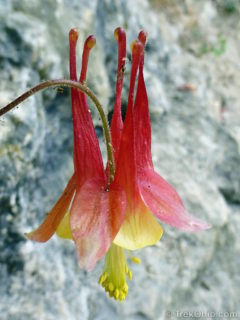 I was delighted at how many species of wildflower were in bloom at Fort Hill this past weekend. We saw many of the same flowers that appeared in April Wildflowers at Lake Katharine State Nature Preserve. So rather than posting duplicate flower photos, I'll just post ones that were newly seen at Fort Hill.
I was delighted at how many species of wildflower were in bloom at Fort Hill this past weekend. We saw many of the same flowers that appeared in April Wildflowers at Lake Katharine State Nature Preserve. So rather than posting duplicate flower photos, I'll just post ones that were newly seen at Fort Hill.
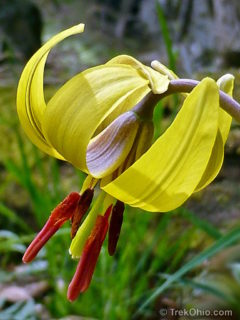 The Ohio Department of Natural Resources lists Lake Katharine State Nature Preserve as being one of the nine state nature preserves in Ohio that are among the best for seeing spring wildflowers. Having never been to this nature preserve in Jackson County, we decided to see what was blooming there in mid-April.
The Ohio Department of Natural Resources lists Lake Katharine State Nature Preserve as being one of the nine state nature preserves in Ohio that are among the best for seeing spring wildflowers. Having never been to this nature preserve in Jackson County, we decided to see what was blooming there in mid-April.
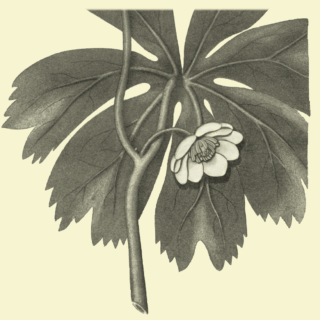 This post illustrates a couple of dozen, common species of spring wildflowers in Ohio. The scientific name in each caption links to an article where you can learn more about that species (a Wikipedia article, if possible). It also lists the months in which you can expect to see each species bloom in central Ohio. In southern Ohio they will bloom a little earlier and in northern Ohio a little later.
Cutleaf Toothwort
The photo below shows some of the foliage.
Mayapple
The blossom
This post illustrates a couple of dozen, common species of spring wildflowers in Ohio. The scientific name in each caption links to an article where you can learn more about that species (a Wikipedia article, if possible). It also lists the months in which you can expect to see each species bloom in central Ohio. In southern Ohio they will bloom a little earlier and in northern Ohio a little later.
Cutleaf Toothwort
The photo below shows some of the foliage.
Mayapple
The blossom 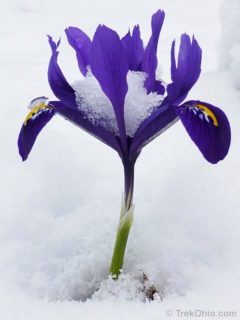 Like much of the northern part of the country, we had a spring snow last night. Today I decided to go on a wintry spring walk at Inniswood Metro Garden to see how the flowers were faring. I invite you to come along!
And here's what the grounds looked like.
And finally I took a look at the children's garden.
The early blooming flowers are pretty hardy, so I'm guessing they'll be okay. I've even heard that the snow insulates and protects them
Like much of the northern part of the country, we had a spring snow last night. Today I decided to go on a wintry spring walk at Inniswood Metro Garden to see how the flowers were faring. I invite you to come along!
And here's what the grounds looked like.
And finally I took a look at the children's garden.
The early blooming flowers are pretty hardy, so I'm guessing they'll be okay. I've even heard that the snow insulates and protects them 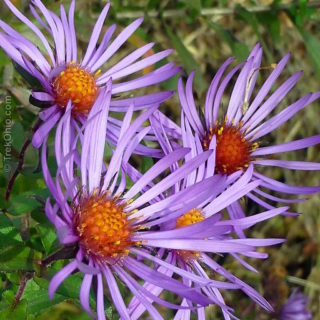 Now that it's November, the wildflower season has come to a close. But let's take a last look at those hardy wildflowers that saw the season out.
And now for one that I didn't see...
A rare and beautiful October wildflower is the Fringed Gentian. In Last call for fen flora, Jim McCormac tells of his trip to Betsch Fen to see these beautiful flowers. Apparently his quest involved wading through a creek and traveling through a woods that was without
Now that it's November, the wildflower season has come to a close. But let's take a last look at those hardy wildflowers that saw the season out.
And now for one that I didn't see...
A rare and beautiful October wildflower is the Fringed Gentian. In Last call for fen flora, Jim McCormac tells of his trip to Betsch Fen to see these beautiful flowers. Apparently his quest involved wading through a creek and traveling through a woods that was without 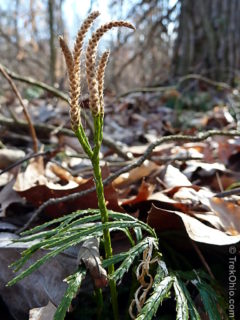 The above plant has a number of names. I'm going to go with Ground Cedar, but it belongs to a family of plants (a genus) that's also called Groundcedar, Crowsfoot, and Clubmoss. I'm not absolutely certain, but I think its specific species is Diphasiastrum digitatum. It is a vascular plant which means that it has veins within its stem and leaves for transporting fluids, minerals and food. Before I became acquainted with it, I had thought that ferns were the only vascular plants that reproduced
The above plant has a number of names. I'm going to go with Ground Cedar, but it belongs to a family of plants (a genus) that's also called Groundcedar, Crowsfoot, and Clubmoss. I'm not absolutely certain, but I think its specific species is Diphasiastrum digitatum. It is a vascular plant which means that it has veins within its stem and leaves for transporting fluids, minerals and food. Before I became acquainted with it, I had thought that ferns were the only vascular plants that reproduced